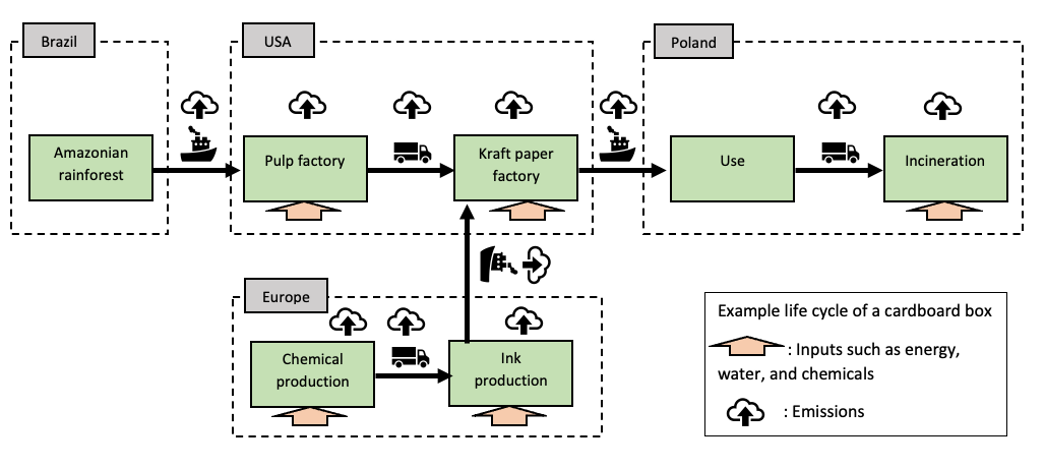The importance of the Life Cycle Perspective
Posted: 27 January 2022

When discussing the environmental impact of packaging, or any product or service in that matter, a concept that will almost always be brought up is the life cycle perspective. Whether it be for a pencil or food delivery, including the whole life cycle into the analysis can shed new light on the environmental impacts caused by the “thing” in focus. While it is quite simple in its definition, when applied to the realities of the intricate world we live in it can become very complex. Yet it cannot be ignored, because if we hope to transition to a sustainable and circular society, it is more important than ever that this perspective is placed on all the things we consume and produce, leaving no stone unturned.
What is a life cycle perspective exactly?
According to the definition by the ISO (International Organization for Standardization):
“A life cycle perspective includes consideration of the environmental aspects of an organization’s activities, products, and services that it can control or influence. Stages in a life cycle include acquisition of raw materials, design, production, transportation/delivery, use, end of life treatment, and final disposal.”
Simply put, the life cycle perspective takes into consideration all aspects of a product’s, service’s, or activity’s life span. In terms of packaging, this means that not just the material is important, but countless other factors. As the ISO definition states, the cycle starts with the harvesting of raw materials and does not end until the final disposal. Along this life cycle, questions need to be asked, such as what chemicals are needed for production, how much water and energy is used up, how much land is required to harvest, and does the condition of this land change dramatically? This list goes on and on and including every single one is vital to ensure that every potential impact is taken into account.
Why is this important?
Well, consider the example of a cardboard box. This box is made of kraft paper that comes from wood chips. Without the life cycle perspective, the cardboard box might seem like a great option. It is made from wood, a renewable source, and can be recycled in most countries. But what if we really break down the life cycle of this specific cardboard box? Say the wood is harvested in Brazil, from non-protected Amazon forests, and is then transported to North America by boat where it is converted into pulp in a factory that uses coal as energy. This pulp is then shipped to another factory on the other side of the US to be manufactured into kraft paper and turned into cardboard. The cardboard gets ink from a company in Europe, which must be shipped to the US by boat. Finally, the finished cardboard box is transported to Poland, where it cannot be recycled but is instead incinerated. When looking at the cardboard box through the lens of the life cycle, it tells a completely different story. Several impacts and inefficient processes would be forgotten, leading to misconceptions and greenwashing.
Below is an example of how the life cycle for the cardboard box could look like. As you see, there are inputs and emissions at every stage. These could be drastically reduced if the process was more localized, meaning the wood is harvested in the same place as the manufacturing, or if instead of incineration, the cardboard box is recycled.

What are the difficulties?
While the life cycle perspective is key in understanding and properly evaluating a product, it can also get very difficult in certain situations. Let us consider the case of the conventional plastic bottle. While the average recycling rates, in general, tend to be quite low for plastics, bottles made from PET are the most recycled, especially in Europe, India, and South Korea. Recycling is a great option for dealing with plastics as it keeps the material in rotation and reduces the need for new plastics, but it does not occur everywhere. Conventional plastics are also a by-product of the oil and gas industry, so as long as oil and gas continue to be extracted and processed, plastics can be cheaply produced on the side. Looking at a life cycle perspective of a plastic bottle that will be recycled in some countries, and that is a byproduct of a larger process, the impacts become hard to categorize. The plastic bottle might seem like a great option if the environmental impacts from the oil and gas process are not included, and if the bottle is assumed to be used, collected, cleaned, and recycled in India with an average recycling rate of 60-70%. But what if the emissions caused by the oil and gas industry are put on the plastic bottle? Since the plastic bottle can be recycled in specific countries, does that make it more sustainable? What if it ends up in countries where it will not be recycled? These are questions that need to be asked, decided upon, and the choice of where to include or cut off needs to be clearly indicated to maintain transparency.
Here at Circulate, we knew from the start that if a packaging product would be considered sustainable, it would have to be sustainable during the whole life cycle. Looking not only at the materials used, but the energy required, the working ethics, whether it was designed for circularity, the chemicals, and even the likelihood of being reused, recycled, or composted in the EU. We hope that after reading this you will have gained some insight into life cycle thinking and have a new understanding of the environmental weight that a product, service, or activity brings with it. So next time you are about to buy something, have a think about the path that this something might have taken before ending up in your hands, and the path it should take after it leaves.